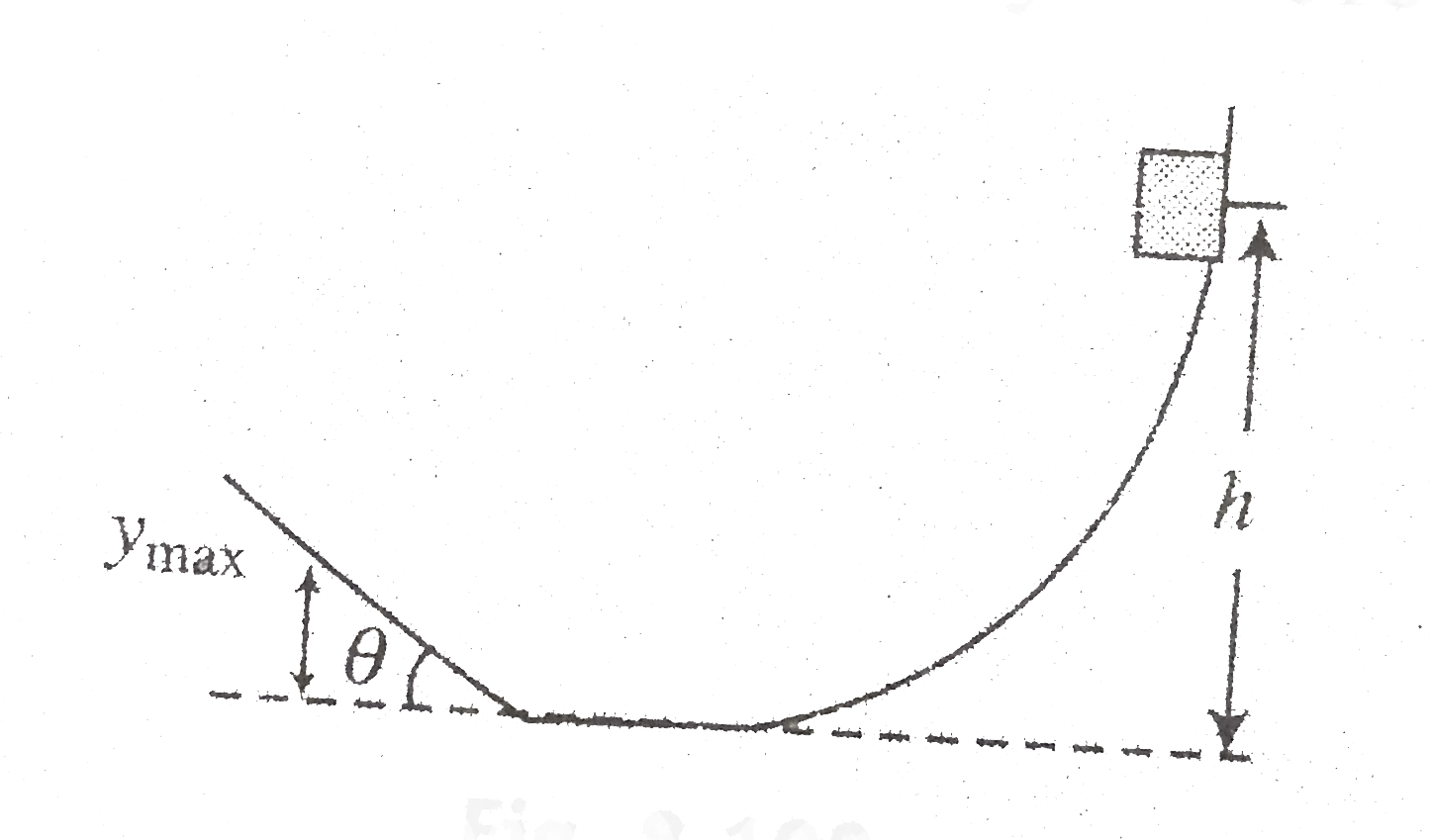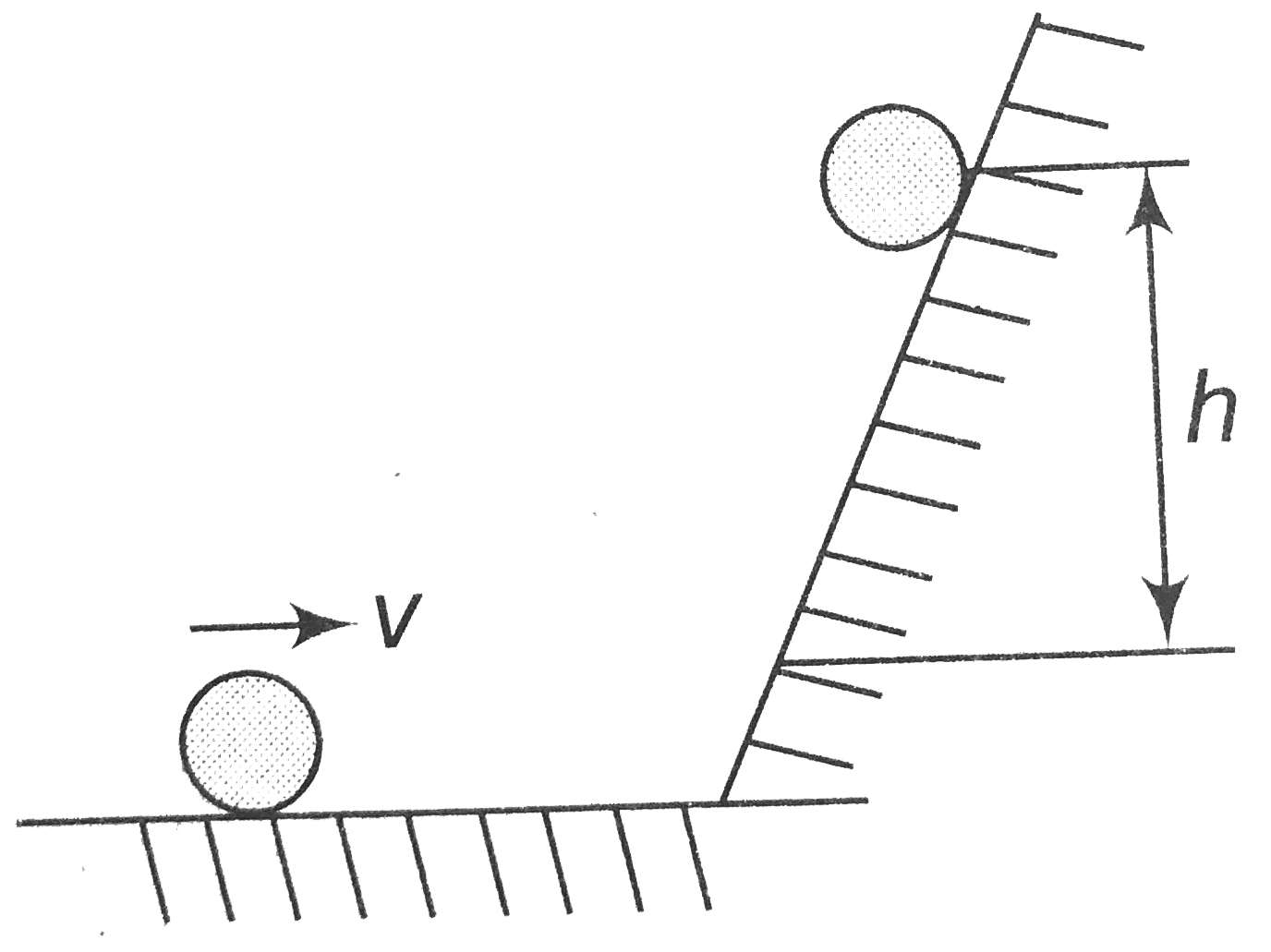Disks A and B are identical and roll across a floor with equal speeds. Then disk A rolls up an incline, reaching a maximum height h, and disk B moves up an incline that is identical except that it is frictionless. Is the maximum height reached by disk B greater than, less than, or equal to h?
To solve the problem, we will use the principle of conservation of energy for both disks A and B.
Step 1: Understand the initial conditions
Both disks A and B are rolling with the same initial speed V on a flat surface before they start ascending their respective inclines.
Step 2: Analyze Disk A
Disk A rolls up an incline with friction. The total mechanical energy at the bottom (initial position) consists of translational kinetic energy and rotational kinetic energy:
- Translational kinetic energy: KEtrans=12mV2
- Rotational kinetic energy: KErot=12Iω2
For a disk, the moment of inertia I is given by I=12mr2 and the relationship between linear velocity V and angular velocity ω is V=rω, which gives ω=Vr.
Substituting ω in the rotational kinetic energy:
KErot=12(12mr2)(Vr)2=14mV2
Thus, the total initial energy for disk A is:
Einitial,A=KEtrans+KErot=12mV2+14mV2=34mV2
As disk A rolls up the incline, it converts this energy into potential energy PE=mgh at the maximum height h:
34mV2=mgh
Solving for h:
h=34V2g
Step 3: Analyze Disk B
Disk B rolls up a frictionless incline. The initial energy is the same as disk A:
Einitial,B=34mV2
However, since there is no friction, the rotational kinetic energy remains unchanged as it rolls up the incline. At the maximum height, all the energy is converted into potential energy and rotational kinetic energy:
34mV2=mgh′+KErot
Where h′ is the maximum height reached by disk B. The rotational kinetic energy remains:
KErot=14mV2
Thus, we have:
34mV2=mgh′+14mV2
Rearranging gives:
34mV2−14mV2=mgh′
24mV2=mgh′⟹12mV2=mgh′
Solving for h′:
h′=12V2g
Step 4: Compare heights
Now we compare h′ and h:
- h=34V2g
- h′=12V2g
Since 34>12, we conclude:
h′<h
Final Answer
The maximum height reached by disk B is less than the maximum height h reached by disk A.
Both disks A and B are rolling with the same initial speed V on a flat surface before they start ascending their respective inclines.
Disk A rolls up an incline with friction. The total mechanical energy at the bottom (initial position) consists of translational kinetic energy and rotational kinetic energy:
- Translational kinetic energy: KEtrans=12mV2
- Rotational kinetic energy: KErot=12Iω2
KErot=12(12mr2)(Vr)2=14mV2
Einitial,A=KEtrans+KErot=12mV2+14mV2=34mV2
34mV2=mgh
Solving for h:
h=34V2g
Disk B rolls up a frictionless incline. The initial energy is the same as disk A:
Einitial,B=34mV2
34mV2=mgh′+KErot
Where h′ is the maximum height reached by disk B. The rotational kinetic energy remains:
KErot=14mV2
Thus, we have:
34mV2=mgh′+14mV2
Rearranging gives:
34mV2−14mV2=mgh′
24mV2=mgh′⟹12mV2=mgh′
Solving for h′:
h′=12V2g
Now we compare h′ and h:
- h=34V2g
- h′=12V2g
h′<h
The maximum height reached by disk B is less than the maximum height h reached by disk A.
Topper's Solved these Questions
- BOOK - RESNICK AND HALLIDAYCHAPTER - RIGID BODY DYNAMICS-IIEXERCISE - PROBLEMS41videos
RIGID BODY DYNAMICS-II
- BOOK - RESNICK AND HALLIDAYCHAPTER - RIGID BODY DYNAMICS-IIEXERCISE - PRACTICE QUESTIONS28videos
RIGID BODY DYNAMICS-II
- BOOK - RESNICK AND HALLIDAYCHAPTER - RIGID BODY DYNAMICS-IIEXERCISE - EXAMPLE1videos
RIGID BODY DYNAMICS-II
- BOOK - RESNICK AND HALLIDAYCHAPTER - RIGID BODY DYNAMICS - IEXERCISE - PRACTICE QUESTIONS (INTEGER TYPE))3videos
RIGID BODY DYNAMICS - I
- BOOK - RESNICK AND HALLIDAYCHAPTER - TEMPERATURE, ZEROTH LAW OF THERMODYNAMICS AND THERMAL EXPANSION EXERCISE - PRACTICE QUETIONS (Integer Type)4videos
TEMPERATURE, ZEROTH LAW OF THERMODYNAMICS AND THERMAL EXPANSION
Similar Questions
From an initial height h, a solid ball rolls smoothly down one side of a U-shaped ramp and then moves up the other side, which is frictionless. What maximum height does the ball reach?
View SolutionTwo identical disks, roll without sliding across a horizontal floor with the same speed and then up inclines. Disk A rolls up its incline without sliding. On the other hand, disk B rolls up a frictionless incline. Otherwise the inclines are identical. Disk A reaches a height 12 cm above the floor before rolling down again. Disk B reaches a height above the floor of :
View Solution
Knowledge Check
- Question 1 - Select One
If R is the horizontal range for θ inclination and h is the maximum height reached by the projectile, Then maximum range is
AR2h+2hBR28h+2hCR28h+8hDR2h+h - Question 2 - Select One
A juggler tosses a ball up in the air with initial speed u. At the instant it reaches its maximum height H, he tosses up a second ball with the same initial speed. The two balls will collide at a height
AH4BH2C3H2D√34H - Question 3 - Select One
A juggler tosses a ball up in the air with initial speed u. at the instant it reaches its maximum height H, he tosses up a seconds ball with same initial speed. The two balls will collide at a height.
AH4BH2C3H4D√34H
A solid sphere of mass 2 kg rolls up a 30∘ incline with an initial speed of 10ms−1. The maximum height reached by the sphere is (g=10ms−2)
View SolutionA body is projected up with a speed u and the time taken by it is T to reach the maximum height H. Pich out the correct statement
View SolutionA block slides down a curved frictionless track and then up an inclined plane as in figure. The coefficient of kinetic friction between the block and incline is μk. Find the maximum height reached by the clock.
 View Solution
View SolutionA stone is projected vertically up to reach maximum height h. The ratio of its potential energy to its kinetic energy at a height 45h, will be
View SolutionA disc of radius R and mass M is rolling horizontally without slipping with speed with speed v. It then moves up an incline as shown in figure. The maximum height upto which it can reach is.
 .View Solution
.View Solution

